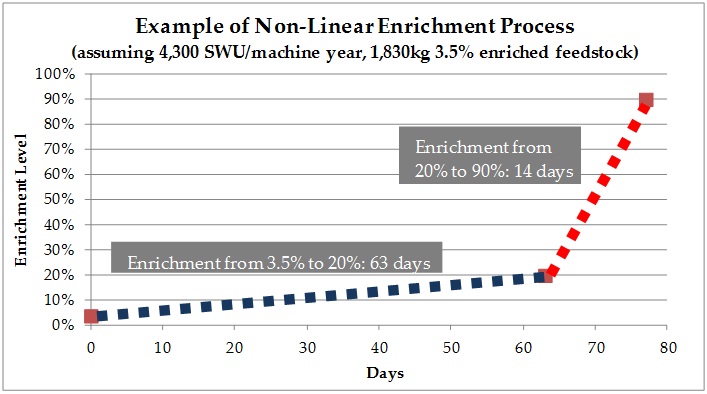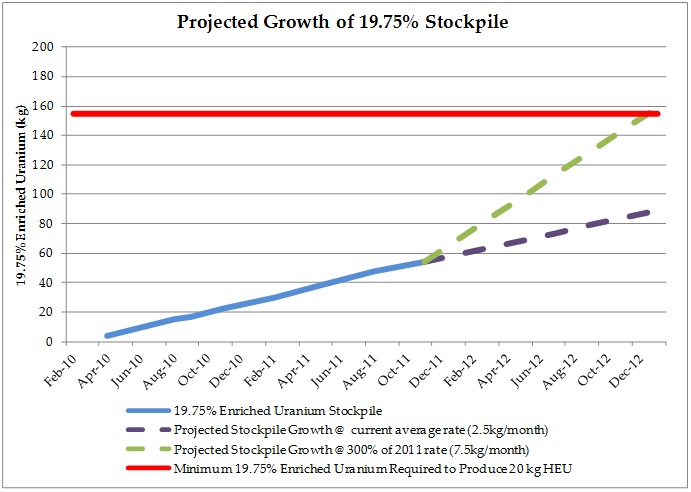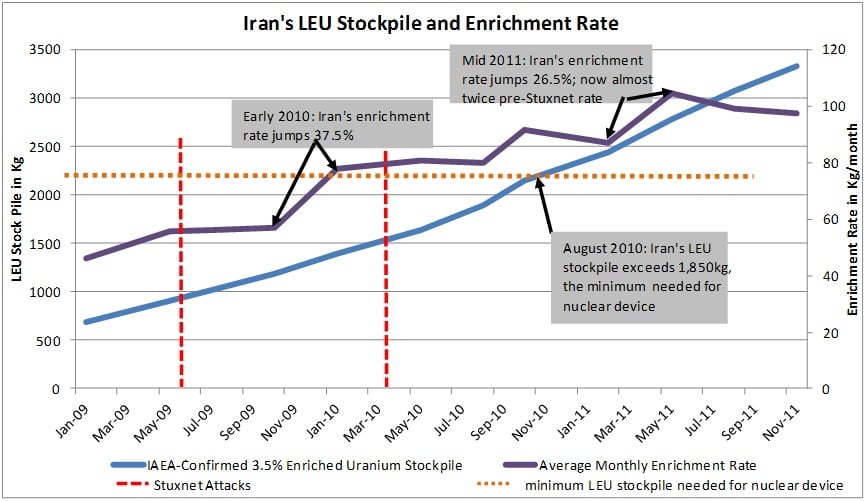The New IAEA Report: Beyond Weaponization
After a year and a half of reports voicing concern about Iran’s work on designing a nuclear weapon, the International Atomic Energy Agency (IAEA) released a lengthy <a href=”http://isis-online.org/uploads/isis-reports/documents/IAEA_Iran_8Nov2011.pdf”>report</a> on November 8, detailing precisely the sort of information that has spurred those concerns. The detailed intelligence, received from its members and gathered by its inspectors, is summarized in an annex to the new report. It is convincing enough that even Iranian officials, when presented with it, “agreed?that, if the information upon which it was based were true, it would constitute a programme for the development of a nuclear weapon.”
Despite the focus on Iran’s weapon program, however, the report also contains important information about the enrichment program. Here are the key points:
- Rate of production of 3.5% enriched uranium at Natanz has dipped slightly, but continues to be among fastest rates documented; remains almost twice as fast as pre-Stuxnet (2009 ? 2010).
- Number of operating centrifuges at the main enrichment facility at Natanz reaches new high.
- Stockpile of 3.5% enriched uranium enough for more than one-and-a-half bombs.
- Stockpile of 20% enriched uranium now at one-third of a bomb’s worth.
- Given current rate of enrichment and stockpiles could have capability to produce enough highly enriched in as little as 58 days.
- Previously secret plant at Qom almost ready to start production of 20% enriched uranium: 412 centrifuges already installed; 3.5% enriched uranium transferred there from Natanz.
Of all these, perhaps the most ominous is the approaching activation of the previously covert Qom enrichment facility buried beneath a mountain. Because enriching uranium to levels of 20% consumes about four-fifths of the time needed to produce weapons-grade (90% enriched) uranium, if Iran succeeds in its stated goal of tripling its current production of 20% enriched uranium at Qom it will have effectively be going 80% of the way towards a nuclear weapon under the watchful eye of the international community. In other words, enrichment at Qom portends a significant leap towards nuclear weapons capability.
Qom Almost Ready for Operation
The Qom installation?officially known as the Fordow Fuel Enrichment Plant (FFEP)?was being secretly built into the side of a mountain when Presidents Barack Obama and Nicolas Sarkozy and Prime Minister Gordon Brown publicly revealed its existence at the G20 summit in Pittsburgh on September 25, 2009. Even since then, although the IAEA has been permitted to inspect the site, Iran has remained evasive about the intended purpose of this facility. After providing the IAEA with official statements in 2010 that the Fordow plant would be used for the production of 3.5% enriched uranium, over the summer of 2011 Iran abruptly announced instead that it would move its production of 20% enriched uranium there. Doing so would be a large, and dangerous, step towards a nuclear weapons capability for Iran.
Iran began producing 3.5% enriched uranium in 2007 at the main facility at Natanz, the below-ground Fuel Enrichment Plant (FEP). In early 2010, it began further enriching its stockpile from 3.5% to almost 20%. It did so at the much smaller research and design-oriented Pilot Fuel Enrichment Plant (PFEP) also located at Natanz, but above ground. Using only 328 centrifuges, Iran has been able to produce a modest amount?about 54 kilograms to date?of 19.7% enriched uranium. By moving its production of this more highly enriched uranium from Natanz to the heavily fortified Fordow facility, however, Iran has specifically stated that it intends to triple its output. But, as State Department spokesperson Victoria Nuland observed,
The Iranian nuclear program offers no plausible reason for its existing enrichment of uranium up to nearly 20 percent, nor ramping up this production, nor moving centrifuges underground.
Iran originally stated that it would enrich uranium to 19.7% in order to produce fuel for the Tehran Research Reactor (TRR), which is used for medical and research purposes. Reasonable estimates of the TRR’s fuel consumption vary between 7 and 10 kilograms of 19.7% enriched uranium per year. This suggests that the amount already stockpiled by Iran could fuel the reactor for at least five years, if not longer. Tripling its current production would provide Iran with quantities of 19.7% enriched uranium far in excess of what it needs for any plausible peaceful nuclear program.
But what such an increased production would provide Iran with is, in effect, a means of “safeguarded breakout.” The term “breakout” signifies any action by Iran that would contravene?effectively break out of?the Safeguards Agreement it has signed with the IAEA. Producing highly enriched uranium or diverting nuclear materials to an unknown facility would constitute a breakout; thus the term is used here to refer to an Iranian attempt to produce enough highly enriched uranium for a nuclear device. By producing large quantities of uranium enriched to levels of almost 20% under the watchful eye of the IAEA and international community, Iran can go about four-fifths of the way towards producing fissile material for a nuclear device, without overtly breaking any safeguards.
The Enrichment Process and Timing
Uranium enrichment is not a linear process; it is not the case, for example, that increasing the enrichment level by a 5% takes the same amount of time regardless of whether the increase is from 0% to 5% or from 85% to 90%, all else being equal. Rather, it is much more time intensive to produce small gains in enrichment at lower levels, than at higher ones. In producing the fissile core of a nuclear weapon?which requires highly enriched uranium, that is, uranium enriched above 90%?just getting to 20% enrichment consumes about four-fifths of the effort.
As an illustration of the enrichment process, it would take Iran 63 days to produce 155 kilograms of 20% enriched uranium from 1,830 kilograms of 3.5% enriched uranium at its main facility at Natanz, given its current rate of enrichment. But it would only take another 14 days of further enrichment to turn that into 20 kilograms of 90% enriched uranium, the minimum needed for a nuclear weapon.
Click the graph to view a larger version.

The Qom facility is so dangerous because every increase in Iran’s stockpile of 20% enriched uranium significantly shortens the time required for a potential breakout, perhaps more so than any likely additional increases in the rate of enrichment at Natanz. In a September 2011 report we cited calculations by Greg Jones, a nuclear expert, which showed that Iran, using its current capabilities and stockpiles, could breakout in 62 days. With a 6 kilogram increase in its stockpile of 20% enriched uranium between August and November 2011, that number has slipped to 58 days. Once Iran produces more than 155 kilograms of 20% enriched uranium, it will be able to produce the 20 kilograms of 90% enriched uranium needed for a nuclear device in two weeks or less.
It is important to understand, however, what these estimates do, and do not, signify. They are a calculation of how long it would take Iran, under the best conditions, to produce the minimum amount of highly enriched uranium needed for a nuclear device. They do not take into account the time needed to develop or assemble a nuclear weapon. Moreover, we do not suggest that Iran will produce a weapon’s worth of highly enriched uranium two months from now, merely that it possesses the capability to do so.
But their capability is set to improve significantly. The IAEA report indicates that Iran is on the brink of beginning to produce 20% enriched uranium at Qom. Iran has installed 412 centrifuges there, already more than the 328 centrifuges currently enriching to 20% at Natanz, though well short of the close to 3,000 the facility is designed to hold, and connected the main power supply to site. More important, Iran has moved one large cylinder of 3.5% enriched uranium from Natanz to Fordow. It is unclear how much uranium that cylinder, which was sealed by the IAEA for the move, contains. But the IAEA planned to remove the seal and install the container at Fordow on November 8, the day the report came out.
Click the graph to view a larger version.

Assuming that Iran achieves its goal of tripling its current rate of production of 20% enriched uranium?going from an average of about 2.5 kilograms per month at Natanz now to roughly 7.5 kilograms per month at Qom?it will surpass the 155 kilogram threshold, and potentially be two weeks away from a nuclear device, in January 2013. With the first centrifuges installed and uranium feedstock already in place, it is just a matter of time before Qom takes a leap towards nuclear weapons capability.
Continued Accelerated Enrichment at Natanz
The main facility at Natanz?the below-ground Fuel Enrichment Plant (FEP)?has thus far been the central locus of Iran’s enrichment program. It is there that Iran has been producing its stockpile of 3.5% enriched uranium and it is believed to have been the main target of the Stuxnet computer worm. Despite that cyber attack and other reported setbacks, however, Natanz continues to enrich uranium at some of the fastest rates documented, as we have argued before.
Between August 13 and November 1, 2011, it produced 256 kilograms of 3.5% enriched uranium, an average monthly enrichment rate of just below 98 kilograms per month. This is a slight decline from the 104 kilogram per month observed between February and May, 2011. Still, it is almost twice the pre-Stuxnet enrichment rate (56 kilograms per month in 2009) and a nearly 20% increase over the 2010 average enrichment rate (83 kilograms per month), further demonstrating that Iran’s enrichment program has accelerated despite Stuxnet.
Another setback that Iran is said to have suffered is difficulty in the procurement of materials needed for the construction of centrifuges. As a result, some experts thought that Iran might have to move centrifuges from Natanz to Qom, rather than produce new ones. Others have speculated that Iran has been forced to use sub-standard materials, resulting in centrifuges that are less effective and that break down more quickly. The IAEA report, however, shows no evidence of either of these scenarios. Click the graph to view a larger version.

Iran now has 6,208 centrifuges spinning at Natanz, the highest number ever and a 35% increase from just a year ago. The total number of centrifuges installed at Natanz, but not necessarily enriching uranium, has remained constant through 2011 at around 8,000. Combined with the 412 centrifuges installed at Fordow, this suggests that Iran is able to produce additional centrifuges for Qom and reliably bring additional centrifuges online at Natanz without demonstrable setbacks.
With the 256 kilograms produced between August and November 1, 2011, Iran has produced a total of 3,327 kilograms of 3.5% enriched uranium. Of this amount, about 517 kilograms have been used to produce 20% enrichment, leaving Iran with a stockpile of 2,809 kilograms of 3.5% enriched uranium. In order to produce, with further enrichment, enough fissile material for a nuclear device?20 kilogram of 90% enriched uranium?Iran needs about 1,850 kilograms of 3.5% enriched uranium. Its current stockpile is already more than one-and-a-half times this amount.
Work on Advanced Centrifuges
In January 2011, Iran submitted plans to the IAEA indicating that it planned to install two new, advanced centrifuge models at the PFEP, Natanz’s research and design facility: 164 each of IR-4 and IR-2m centrifuge models. Outside experts have suggested these new centrifuges could raise production rates as much as six times higher than the current IR-1 model. Iran began installing the new centrifuges over the summer. The IAEA reports that they have now installed 164 IR-2m centrifuges and placed them under vacuum, though it does not say whether or not they have begun enriching yet. It also found 66 of the IR-4 centrifuges installed, but not enriching.
For a larger version of the table below, please click here to zoom in.

Share
Read Next
Support Research Like This
With your support, BPC can continue to fund important research like this by combining the best ideas from both parties to promote health, security, and opportunity for all Americans.
Give Now